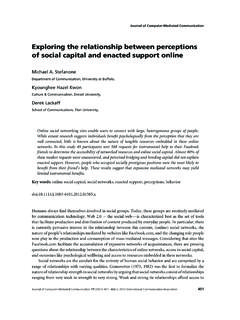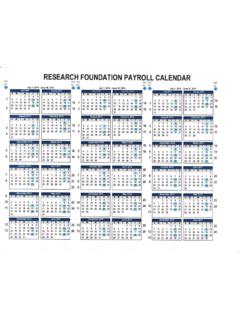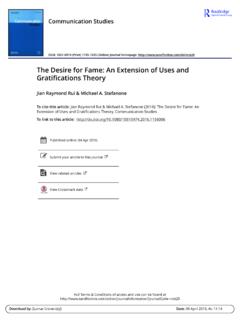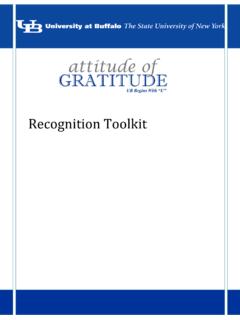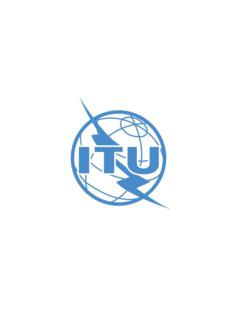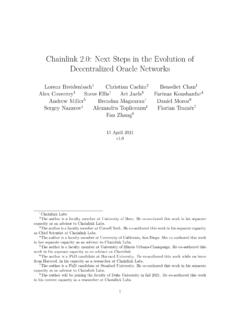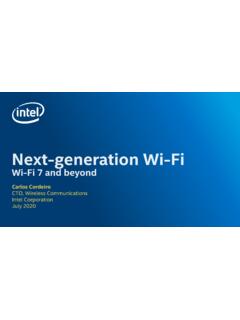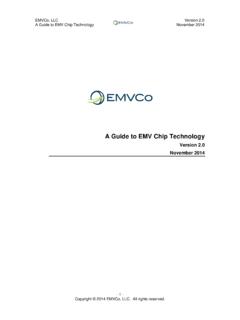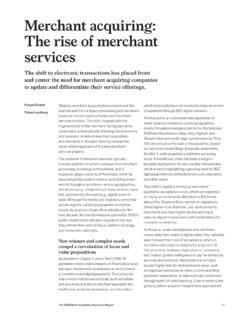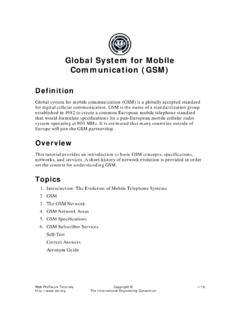Transcription of BLOCKCHAIN - University at Buffalo
1 BLOCKCHAINWhat is Copyright 2017 | All Right ReservedNo prior knowledge of blockchains requiredWe ll be looking at Bitcoin, but mostly talking BlockchainStart with a simplified overview of how it all works, then dive deeper into each sectionLETS STARTAT THE BEGINNING Copyright 2017 | All Right ReservedPage 4 OVERVIEW Class time: (2 pm 6 pm) 6 modules organized into 45 minute sessions 5 min Q&A (flexible) 10 minute break Start at top of the hour Instructor available for additional Q&A at end of call Copyright 2017 | All Right ReservedPage 5 OVERVIEW and OBJECTIVES Objectives What is BLOCKCHAIN , technical overview, business use cases Modules to is and Decentralized Materials, Certificate of Completion, FeedbackINTRODUCTION & PRIMERWhat you need to know Copyright 2017 | All Right ReservedPage 7 What is BLOCKCHAIN ?
2 BLOCKCHAIN technology is a software; a protocol for the secure transfer of unique instances of value ( money, property, contracts, and identity credentials) via the internet without requiring a third-party intermediary such as a bank or government Email over IP, Voice over IP, Money over IPInternetBlockchainBitcoinApplicationPr otocol InfrastructureSMTPE mailVoIPPhone calls Copyright 2017 | All Right ReservedPage 8 How does Bitcoin work? Use eWallet app to submit transactionSource: recipient s address and submit transaction$ appears in recipient s eWalletWallet has keys not moneyCreates PKI Signature address pairsA new PKI hashed signature for each transaction Copyright 2017 | All Right ReservedPage 9P2P network confirms & records transactionsSource: computationally confirmed Ledger account balances updatedPeer nodes maintain distributed ledgerTransactions submitted to mempool, and miners assemble new batch (block) of transactions each 10 minEach block includes a cryptographic hash of the last block, chaining the blocks, hence BLOCKCHAIN Copyright 2017 | All Right ReservedPage 10 How robust is the Bitcoin p2p network?
3 P2p: peer to peer; Source: , 11,678 global nodes run full Bitcoind (2/18); 160 gb Copyright 2017 | All Right ReservedPage 11 What is Bitcoin mining?Mining is the accounting function to record transactions, fee-based ($130,000/block each 10 min)Mining ASICs discover new blocks Mining software makes nonce guesses to win the right to record a new block ( discover a block )At the rate of 2^32 (4 billion) hashes (guesses)/secondOne machine at random guesses the 32-bit nonce Winning machine confirms and records the transactions, and collects the rewardsAll nodes confirm the transactions and append the new block to their copy of the distributed ledger Wasteful effort deters malicious playersRun the software yourself:Fast because ASICs represent the hashing algorithm as hardware Copyright 2017 | All Right ReservedPage 12 Key BLOCKCHAIN Concepts Public-private networks Trustless vs trusted Distributed network Consensus algorithms Immutability BLOCKCHAIN : trustless, distributed (peer-based), consensus-driven, immutable Copyright 2017 | All Right ReservedPage 13 What is a Ledger?
4 A ledger is like a database, a Google or Excel spreadsheet Add new records by appending rows Each row contains information Account balances, who owns certain assets Memory and execution state of a computer program Copyright 2017 | All Right ReservedPage 14 Why Distributed? Distributed network Many nodes or peers that are connected in a network with no single point of failure or centralized control Security and resiliency: design the network so that if some peers crash or attack the network maliciously, the network can still operate (Byzantine Fault Tolerance) Copyright 2017 | All Right ReservedPage 15 What is Immutable? Cannot change the data once its committed to the ledger Data is auditable Change by issuing offsetting transaction Smart contract code Copyright 2017 | All Right ReservedPage 16 Cryptographic Identity To use the network, need a Cryptographic Identity (sort of like an email address) If want to access your email, you need the password, which functions similarly to a private key and your public key is like your address (more complicated) Authentication.
5 Peers sign transactions with their cryptographic identity, this enables account ownership and can attribute blame Copyright 2017 | All Right ReservedPage 17 Consensus in Distributed Networks In order to update the ledger, the network needs to come to consensus using an algorithm Consensus: what does it mean to come to consensus on a distributed network? It means that everyone agrees on the current state ( how much money does each account have) and making sure that no one is double-spending money (easy in Bitcoin, more complex in Ethereum, business networks) How do we come to consensus in this distributed manner? Copyright 2017 | All Right ReservedPage 18 Three Primary Consensus Algorithms POW: Proof of Work (Bitcoin) Expensive, not ecological, wasteful computation POS: Proof of Stake (Ethereum) next -gen: PBFT: Practical Byzantine Fault Tolerance (DFINITY, Algorand) Law of large numbers.
6 Diversity of participants For each block of transactions, randomly select a small, one-time group of users in a safe and fair way To protect from attackers, the identities of these users are hidden until the block is confirmed The size of this group remains constant as the network grows Copyright 2017 | All Right ReservedPage 19 Key BLOCKCHAIN Concepts Public-private networks Trustless vs trusted Distributed network Consensus algorithms Immutability BLOCKCHAIN : trustless, distributed (peer-based), consensus-driven, immutable Copyright 2017 | All Right ReservedPage 20 What problem does BLOCKCHAIN solve? Trip to the Bar Copyright 2017 | All Right ReservedPage 21 What is BLOCKCHAIN Common Ledger Copyright 2017 | All Right ReservedPage 22 What is BLOCKCHAIN A More Common LedgerBLOCKCHAIN ADOPTIONOne of the fastest-moving technology adoptions Copyright 2017 | All Right ReservedPage 24 BLOCKCHAIN Adoption BLOCKCHAIN (distributed ledger technology)
7 Is being considered by more than half of the world's big corporations, according to a Juniper market research survey released Jul 2017 57 percent of large corporations defined as any company with more than 20,000 employees were either actively considering or in the process of deploying BLOCKCHAIN Two-thirds of companies surveyed by Juniper said that they expected the technology to be integrated into their systems by the end of 2018 IDC: $ billion estimated global BLOCKCHAIN spend 2018 Copyright 2017 | All Right ReservedPage 25 BLOCKCHAIN Copyright 2017 | All Right ReservedPage 26 The Future of BlockchainTransforming Society BLOCKCHAIN technology is bringing us the Internet of value: a new platform to reshape the world of business It transcends all physical and geographical barriers and uses math and cryptography to enable transactions globally.
8 The uniqueness of BLOCKCHAIN lies in its capacity to store and retain person-to-person transactional history, so that chances of fraud, hacking, and third-party interference are OVERVIEWThe BLOCKCHAIN is: Decentralized Immutable Transparent Disintermediated Consensus-based Copyright 2017 | All Right ReservedPage 28 BLOCKCHAIN combines existing technologies to prevent the double-spend problemCleverly combined software components Distributed Systems Peer-to-peer networks Hashing functions Public - Private key cryptography Cryptographic signatures Elliptic curve cryptography Copyright 2017 | All Right ReservedPage 29 USE CASES Background checks: education credentials, criminal records Secure document storage: home deed, auto title Birth registries Land registries Financial services: securities clearing, syndicated loans Global supply chain: automotive recalls and counterfeit airbags Healthcare: EMRs, insurance claims, genome research Airlines: registration, re-booking, vouchers, loyalty Tokenized economy: Tech Coworkingspace 1 token = 1 seat Payment channels: Starbucks or for bandwidth consumption IT S ALLABOUT TRANSACTIONS Copyright 2017 | All Right ReservedPage 31 CASH IS PEER TO PEERO bservations: No middleman required DIY Fraud detection Sufficient trust for the value of the transaction Anonymous/Private Distributed Copyright 2017 | All Right ReservedPage 32 ELECTRONIC MIDDLEMENO bservations.
9 Requires 3rd party trust The more complex the flow, the more middlemen required Specialized equipment needed ( POS terminal, connection to Txnnetworks Fraud detection by 3rd parties Every step adds costMerchantProcessorNetworksCredit Card BillMerchant BankCard IssuingBATCHDAILY DEPOSIT Copyright 2017 | All Right ReservedPage 33 MIDDLEMEN ADDING VALUE Provision of infrastructure(Terminals, network connections, etc.) Management of commercial relationships between parties (Lots of lawyers) Abstraction of complexity Fraud detection Customer service Regulatory compliance KYC, AML, Risk reporting Removal of bad-actors from the ecosystemUntil now, this is the best way we ve been able to achieve the goal of person-to-person transactions at a distance.)
10 Copyright 2017 | All Right ReservedPage 34 BLOCKCHAIN POWERED PAYMENT NETWORKSNow: Online banking transaction growth SME s/Retail acceptance of electronic transactions Online purchases/Commerce In -App purchases Virtual currencies in games International Transaction growth (Commerce and Remittance) Value storage cards (loyalty cards, ERP, gift cards etcetc)Future: Internet of Things Autonomous Objects Programmable money/Finance automationIN easier it is to conduct transactionsthe more people transact. Copyright 2017 | All Right ReservedPage 36 LIMITATIONS Cash is only useful locally and small amounts Electronic transactions require Credit/Debit card-Fees are high for merchants (Fixed Fee + 1-3%)-Settlement is slow (multiple days)-Chargebacks shift risk to merchant-Microtransactionsare cost prohibitive Walled garden/In-country solutions are piecemeal International Transfers ITT/Swift-Slow, costly, mistake prone High onboarding costs/bureaucracy 2 billion world-wideunderbanked (PWC 2016) Copyright 2017 | All Right ReservedPage 38 BLOCKCHAIN POWERED PAYMENT NETWORKSS olved: Return to Peer-to-Peer Speed Trustless trust No special equipment needed Fraud Minimal Cost No chargebacks No monthly fees TransparencyIgnored.
